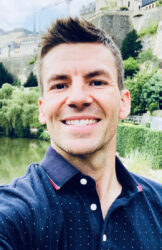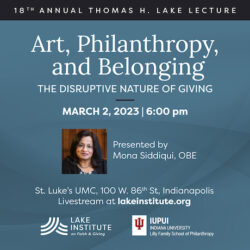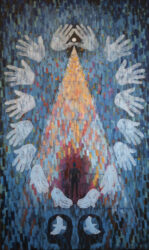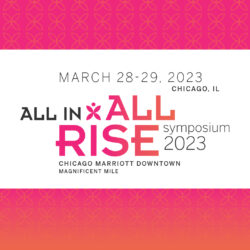Art, Religion, and Philanthropy
Art, Religion, and Philanthropy
The work of Lake Institute attests to the relationship between religion and philanthropy. It is well known that active members of religious communities are more likely to be philanthropic. And of course, much philanthropy goes to support religious institutions. On the other hand, the relationship between art and philanthropy appears, on the surface, to be unidirectional. But while much philanthropy is directed to support artistic endeavors, art is not just a beneficiary of philanthropic largesse, but a benefactor as well.
In a way, art, religion, and philanthropy arise from the same source. They come from keen attentiveness to the world, outside us and within us. In Hebrew we ask one another for our attention with the appeal, sim lev. It means “place your heart.” As the poet Mary Oliver reminds us, “attention is the beginning of devotion.” Attentiveness, with your whole heart, is the driving force behind creativity, spiritual devotion, and generosity.
Attentiveness with Your Whole Heart
Jewish tradition gives us a metaphor through which to understand this concept. The rabbis have suggested that Biblical interpretation can be symbolized like being in an orchard. Just as the orchard provides shade and fruit for those who enter, the text offers inspiration and meaning to those who read it. But it is a two-way street. The orchard flourishes because of the attentiveness, the care and nurture of those who come to enjoy it. These caregivers are akin to the religious interpreters and artists who critique, translate, and unravel the text through story, visual image, and music. Without them the text would die and become obsolete. They make palpable the prophetic and aesthetic vision that inspires philanthropy. They expand our attention from the parochial to the global, from the individual to the community, from the private to the public.
Annie Dillard suggests that the significant animating force of great art is the artist’s willingness to hold nothing back and to create with a generous spirit. About writing, she says: “Anything you do not give freely and abundantly becomes lost to you. You open your safe and find ashes.” The generosity that is required to inspire philanthropy comes from the same wellspring as the generosity of spirit that serves as muse for great art and religion.
Connecting Artists with Religious Narratives
Making these connections is what Religion, Spirituality, and the Arts Program (RSA) at IUPUI has been doing for the past decade. By connecting artists with religious narratives in a sustained and thoughtful conversation, RSA cultivates the relationship between art and religion and creates new paths for exploring personal and communal spiritual values. Artists are welcomed into the “orchard” holding nothing back. Unincumbered by doctrinal expectation or restrictions of patronage and institution, artists engage the sacred sources and imagine a place where religion, like art and philanthropy, enlarges possibilities rather than restricting them.
This is illustrated by a recent creation by an RSA artist, Addie Hirschten. She was inspired by the encounter with a young man and woman in a homeless encampment near her home. She warned the two that the area often flooded, then gave them food and a map of local shelters. A few weeks later she was grieved to learn that the young man had died.
Addie’s painting, “Jacob’s Dream,” reimagined the biblical story of Jacob’s dream. It brought her experience to bear on the ancient narrative: “I decided that the angels climbing the ladder would take the form of hands that are there to lift someone up.” In her art, biblical text intersected with life to open a window to invite the spirit of generosity.
Paying Attention to the World
Works of art have had the power not only to inspire personal transformation but also to generate social change. This is demonstrated by an art installation in Indianapolis. El Tendedero (the Clothesline) was originally conceived as a participatory work by Mexican artist Monica Mayer in 1978 for the Museo de Art Moderno in Mexico City. Mayer asked women to share what they most disliked about their city. The women’s responses, written on small pieces of paper, were attached to a clothesline.
El Tendedero has been reenacted around the globe as part of exhibitions as well as acts of public protest. Women4Change Indiana welcomed Mayer to bring El Tendedero to Indiana as part of a statewide initiative to persuade lawmakers to pass legislation defining legal consent. Women were invited to reflect and to write on their own experiences with sexual assault. Over 1500 cards written by residents of all 92 Indiana counties were attached to a clothesline that was placed in the Rotunda of the State House to highlight the extent of domestic abuse and sexual violence in the state. This art installation helped legislators see what had been ignored and prompted the Indiana Legislature to pass a bill defining consent. This exhibition is now at the Indianapolis Museum of Art at Newfields.
Art, religion, and philanthropy are about paying attention to the world, especially the people, places, and moments we are inclined to ignore. They are about asking questions: What’s wrong? What’s missing? Where are you? Where is your brother, your sister? Who is your neighbor? What do you see? What is your responsibility? They share a search for meaning, purpose, and transformation and their intersection generously enriches our communities.
Rabbi Sandy Eisenberg Sasso, D.Min. is Rabbi Emerita of Congregation Beth-El Zedeck, Indianapolis, Indiana where she served for 36 years, and is presently director of the Spirituality, Religion. Spirituality, and the Arts Initiative at Indiana University-Purdue University in Indianapolis. Rabbi Sasso was the first woman ordained at the Reconstructionist Rabbinical College in 1974. She is the author of award-winning children’s books and is a co-founder of Women4Change Indiana, a statewide organization of 5000 focus on creating positive change for women.
Questions for Reflection
-
- Have you ever considered the connection between art, religion, and philanthropy? If not, what stands out to you about this connection?
- “Just like artists often lead us to imagine something different outside of our day-to-day lives, commands and encouragements to give serve as a necessary disruption from our natural inclinations.” How do you see this statement from our upcoming Thomas H. Lake Lecturer, Dr. Mona Siddiqui, connected to Rabbi Sasso’s essay?
Expanded Perspective
 by Ronnie Plasters, William and Edie Enright Fellow, IU Lilly Family School of Philanthropy
by Ronnie Plasters, William and Edie Enright Fellow, IU Lilly Family School of Philanthropy
I cut my teeth as a fundraiser at the University of Chicago before UC Berkeley saved me from the tumultuous winters of the windy city. Much to my surprise, a prominent Bay-area arts organization approached me, and in short order, I found myself leading a development team in the riveting, dramatic world of the arts.
I didn’t fathom that religiosity would surface prominently in this role—at least not so frequently nor so overtly. In fact, my master’s in religious studies proved far more helpful in this beloved arts community than ever before. Donors brought their full humanity to the artistic endeavor, uniting their spirituality with their generosity in and through the arts. They invested not just to indulge their palates; rather, they contributed to help enhance and sustain a community where artistic and religious devotion fused in shared artistic spirit.
Two learnings remain from the five years I served this arts organization that I hope might also resonate with you. First, preconceived notions that one might assume about art as an “othered” experience no longer hold merit. The relationship between artist and participant is codified not in the consumption of their art, but in the transformation of thought and action—even spirit—because of entering into the creative relationship. As Sandy Eisenberg Sasso shared so eloquently, the orchard isn’t just a space of shady reprieve or satiation. It invites nurture and investment. Art, like the orchard, invites nurture and care even as it fuels the spirit. It’s a relationship.
Second, thinking of myself as creative frightens me far less now than it once did. I remember an assignment in my undergraduate art history class: the dreaded self-portrait. I recall thinking, “let’s just leave the art up to the artists; I’m just here for the gen-ed.” But, as psychologist Brene Brown declares, we do not choose creativity; rather, we are created creative. We might stifle our inner artist or try to judge our artistic endeavors. Either approach assures that we deny our divine origin. I now consider myself as simply creative. Indeed, it is a vital aspect of my divinely inspired humanity. I am not bold enough yet to adorn the ‘artist’ title, but I am leaning into my creativity with the help of fellow creatives in my community. I invite you, too—whether fundraiser, artist, or, like me, just a creatively created being—to embrace your inner artist.
Thomas H. Lake Lecture
 This Thursday, March 2, in her Thomas H. Lake lecture, Dr. Mona Siddiqui will explore the role that religious traditions play in encouraging us to be generous givers. While our religious traditions may differ, through attending to texts and voices from within the Muslim and Christian traditions, Siddiqui will note how important our religious traditions are in transforming us into givers often against our basic nature. Just as artists help us to imagine something different outside of our day-to-day lives, commands and encouragements to give can provide a needed disruption of our natural inclinations.
This Thursday, March 2, in her Thomas H. Lake lecture, Dr. Mona Siddiqui will explore the role that religious traditions play in encouraging us to be generous givers. While our religious traditions may differ, through attending to texts and voices from within the Muslim and Christian traditions, Siddiqui will note how important our religious traditions are in transforming us into givers often against our basic nature. Just as artists help us to imagine something different outside of our day-to-day lives, commands and encouragements to give can provide a needed disruption of our natural inclinations.
All in, All Rise: Women's Philanthropy Institute Symposium
Learn more about All In, All Rise, a symposium organized by the Women’s Philanthropy Institute (WPI) at the Indiana University Lilly Family School of Philanthropy. Focused on the broad landscape of women and philanthropy, the national event will explore how women’s generosity strengthens communities, encourages greater strategic giving, and builds a more diverse network of engaged citizens. The two-day event will take place in Chicago on March 28 – 29. Filled with action-oriented conversations and ample networking opportunities, you don’t want to miss All In, All Rise!
Subscribe
Insights, a bi-weekly e-newsletter, is a resource for the religious community and fundraisers of faith-based organizations that provides:
- Reflections on important developments in the field of faith and giving
- Recommended books, studies and articles
- Upcoming Lake Institute events



